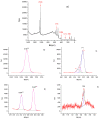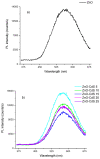Cytotoxicity, Antioxidant, Antibacterial, and Photocatalytic Activities of ZnO-CdS Powders
- PMID: 31906422
- PMCID: PMC6981413
- DOI: 10.3390/ma13010182
Cytotoxicity, Antioxidant, Antibacterial, and Photocatalytic Activities of ZnO-CdS Powders
Erratum in
-
Correction: Zgura et al. Cytotoxicity, Antioxidant, Antibacterial, and Photocatalytic Activities of ZnO-CdS Powders. Materials 2020, 13, 182.Materials (Basel). 2021 Dec 14;14(24):7713. doi: 10.3390/ma14247713. Materials (Basel). 2021. PMID: 34947509 Free PMC article.
Abstract
In this work, ZnO-CdS composite powders synthesized by a simple chemical precipitation method were thoroughly characterized. The morphological, structural, compositional, photocatalytical, and biological properties of the prepared composites were investigated in comparison with those of the pristine components and correlated with the CdS concentration. ZnO-CdS composites contain flower-like structures, their size being tuned by the CdS amount added during the chemical synthesis. The photocatalytic activity of the composites was analyzed under UV irradiation using powders impregnated with methylene blue; the tests confirming that the presence of CdS along the ZnO in composites can improve the dye discoloration. The biological properties such as antioxidant capacity, antibacterial activity, and cytotoxicity of the ZnO, CdS, and ZnO-CdS composites were evaluated. Thus, the obtained composites presented medium antioxidant effect, biocidal activity against Escherichia coli, and no toxicity (at concentrations less than 0.05 mg/mL for composites with a low CdS amount) for human fibroblast cells. Based on these results, such composites can be used as photocatalytic and/or biocidal additives for photoactive coatings, paints, or epoxy floors, which in their turn can provide a cleaner and healthier environment.
Keywords: ZnO–CdS composites; antibacterial activity; antioxidant capacity; cytotoxicity; methylene blue discoloration.
Conflict of interest statement
The authors declare no conflicts of interest. The funders had no role in the design of the study; in the collection, analyses, or interpretation of data; in the writing of the manuscript, or in the decision to publish the results.
Figures












Similar articles
-
Burdock-Derived Composites Based on Biogenic Gold, Silver Chloride and Zinc Oxide Particles as Green Multifunctional Platforms for Biomedical Applications and Environmental Protection.Materials (Basel). 2023 Jan 29;16(3):1153. doi: 10.3390/ma16031153. Materials (Basel). 2023. PMID: 36770157 Free PMC article.
-
Facile synthesis of a novel nitrogen-doped carbon dot adorned zinc oxide composite for photodegradation of methylene blue.Dalton Trans. 2020 Dec 22;49(48):17725-17736. doi: 10.1039/d0dt02756a. Dalton Trans. 2020. PMID: 33237044
-
Hybrid Cellulosic Substrates Impregnated with Meta-PBI-Stabilized Carbon Nanotubes/Plant Extract-Synthesized Zinc Oxide-Antibacterial and Photocatalytic Dye Degradation Study.Nanomaterials (Basel). 2024 Aug 14;14(16):1346. doi: 10.3390/nano14161346. Nanomaterials (Basel). 2024. PMID: 39195384 Free PMC article.
-
Sandwiched ZnO@Au@CdS nanorod arrays with enhanced visible-light-driven photocatalytical performance.Nanotechnology. 2017 Nov 17;28(46):465403. doi: 10.1088/1361-6528/aa8d43. Nanotechnology. 2017. PMID: 28920580
-
Photocatalytic and antibacterial activity of cadmium sulphide/zinc oxide nanocomposite with varied morphology.J Colloid Interface Sci. 2016 Oct 15;480:9-16. doi: 10.1016/j.jcis.2016.06.073. Epub 2016 Jun 30. J Colloid Interface Sci. 2016. PMID: 27399614
Cited by
-
Photocatalytic-Driven Antiviral Activities of Heterostructured BiOCl0.2Br0.8 - BiOBr Semiconductors.ACS Omega. 2024 Apr 10;9(16):18183-18190. doi: 10.1021/acsomega.3c10310. eCollection 2024 Apr 23. ACS Omega. 2024. PMID: 38680376 Free PMC article.
-
Burdock-Derived Composites Based on Biogenic Gold, Silver Chloride and Zinc Oxide Particles as Green Multifunctional Platforms for Biomedical Applications and Environmental Protection.Materials (Basel). 2023 Jan 29;16(3):1153. doi: 10.3390/ma16031153. Materials (Basel). 2023. PMID: 36770157 Free PMC article.
-
Improved Bacteriostatic and Anticorrosion Effects of Polycaprolactone/Chitosan Coated Magnesium via Incorporation of Zinc Oxide.Materials (Basel). 2021 Apr 12;14(8):1930. doi: 10.3390/ma14081930. Materials (Basel). 2021. PMID: 33921460 Free PMC article.
-
Correction: Zgura et al. Cytotoxicity, Antioxidant, Antibacterial, and Photocatalytic Activities of ZnO-CdS Powders. Materials 2020, 13, 182.Materials (Basel). 2021 Dec 14;14(24):7713. doi: 10.3390/ma14247713. Materials (Basel). 2021. PMID: 34947509 Free PMC article.
-
Facile Use of ZnO Nanopowders to Protect Old Manual Paper Documents.Materials (Basel). 2020 Nov 30;13(23):5452. doi: 10.3390/ma13235452. Materials (Basel). 2020. PMID: 33266076 Free PMC article.
References
-
- Zhang Q., Ma L., Zhao Q., Li Z., Xu X. Mophology-Modulations of TiO2 Nanostructures for Enhanced Photocatalytic Performance. Appl. Surf. Sci. 2015;332:224–228. doi: 10.1016/j.apsusc.2015.01.052. - DOI
-
- Nakata K., Fujishima A. TiO2 Photocatalysis: Design and Applications. J. Photochem. Photobiol. C Photochem. Rev. 2012;13:169–189. doi: 10.1016/j.jphotochemrev.2012.06.001. - DOI
-
- Ong C.B., Ng L.Y., Mohammad A.W. A review of ZnO nanoparticles as solar photocatalysts: Synthesis, mechanisms and applications. Renew. Sustain. Energy Rev. 2018;81:536–551. doi: 10.1016/j.rser.2017.08.020. - DOI
-
- Chaengchawi P., Serivalsatit K., Sujaridworakun P. Synthesis of visible-light responsive CdS/ZnO nanocomposite photocatalysts via simple precipitation method. Key Eng. Mater. 2014;608:224–229. doi: 10.4028/www.scientific.net/KEM.608.224. - DOI
Grants and funding
- PN19-03 (contract no. 21 N/08.02.2019)/Romanian Ministry of Research and Innovation
- PN 18 09 02 02/2018/Romanian Ministry of Research and Innovation
- PN 19 06 02 03/2019/Romanian Ministry of Research and Innovation
- Project No. 44/2019 (IUCN ORDER no. 397/27.05.2019)/Romanian Ministry of Research and Innovation
LinkOut - more resources
Full Text Sources

